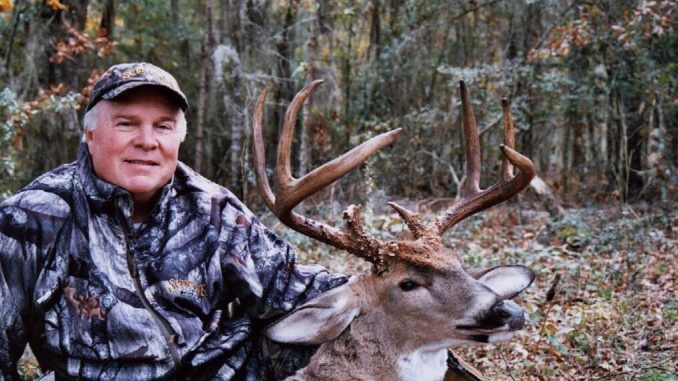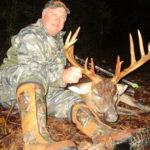
Image scouting, pinch points, natural foods and patience are all keys to Randy Lambert’s deer tactics
When Randy Lambert of Barnwell may not be a poker player, but he knows how to play the cards he’s been dealt at the beginning of every deer season.
A 61-year-old employee of the U.S. Department of Agriculture’s Farm Service Agency, Lambert has killed, by his own estimation, around 350 deer, most of them since he picked up a bow for the first time in 1979 and shortly thereafter, put his guns away for good.
Lambert doesn’t toot his own horn; he rarely mounts a buck, even though hunting buddies estimate that he’s killed several Pope and Young Club qualifiers. His 2013 trophy, taken on Nov. 30, was so big that, according to sources, after two wildlife officers taped the buck at around 149 inches, they threatened to write him a ticket if he didn’t have it mounted.
Before he steps into the woods in Barnwell and Abbeville counties, he has four aces up his sleeve, and he makes sure he uses them all.
Imagery
Lambert is a huge believer in visiting an area from his kitchen table or the front of a computer before he ever sets foot on it to scout for deer.
“The biggest thing I do is get a topo map or an aerial photo or look at a good imaging system. A topo map can show you elevation changes and streams, and with an aerial photo or good imagery, you can see woods and fields, and you can look for places to put up a stand,” he said. “With an aerial photo, you can tell oak trees from pines — they have bigger crowns.
“This really helps me when I’m hunting WMA lands, especially the ones that offer the quality management hunts,” he said. “I’ll find places I like, then I’ll visit them on foot. I’ll look at them real close. But the maps and imagery gives me a real starting point.”
The things Lambert is looking for on topo maps and aerial photos are what are commonly called “pinch points” and often referred to as “funnels” — areas where the landscape naturally concentrates deer movements between feeding and bedding areas.
“I’ve seen pinch points produce some pretty quality deer,” he said, “and I don’t think that you don’t really need food nearby.”
Lambert described two pinch points that he regularly hunts.
“On one particular place I’ve got on one tract of land I hunt, there’s a long drainage that’s loaded with big trees,” he said. “He starts out on top of the farm, and is runs all the way down to a big cutover where they bed and a main creek. The deer walk that drainage when they come out at night to feed in the soybean, peanut and corn fields, and they walk it back to their bedding area. I try and place a stand close to the cutover, but not it in. I want to be close to his bed, not in it.
“I really love to find hedgerows, too. I have one hedgerow that’s about 50 yards wide, and it has cutovers on both sides of it. They travel in that hedgerow. With it being 50 yards wide, I can almost put up one stand and shoot both sides.”
Food, water, cover
Randy Lambert rarely sets up a deer stand directly over an agricultural field or food plot, but they’re a big part of his hunting strategy; he wants to know where major food sources are, what they are, and then he tries to intercept deer on their way to and from the dinner table.
“Genetics and the kind of food the deer have are two key factors in killing big deer,” he said. “I have one farm I hunt that is planted in perennial peanuts, 170 acres. It’s a tremendous, high-protein hay that is marketed for horse farms, for horses that race, like thoroughbred. It’s similar to the alfalfa they grow out west, and it’s such good, quality, high-protein food, we’ve killed some 180- to 200-pound deer there. Nothing can compare to it. Bermuda grass hay, for example, sells for about $70 a ton. This sells for $275 a ton.”
Fields cultivated with soybeans, peanuts and corn are a big draw for deer, and Lambert recognizes their importance. But there’s another crop that isn’t produced with plows and fertilizer that’s much more important, he said.
“I’d much rather hunt over natural foods than to put out corn,” he said. “Any time I can find acorns in the woods, I’ll try and hunt in that area. And if you’re in a year when there aren’t many acorns dropping and you find one tree that’s dropping them, all the deer will be there.
“I hunt one big oak tree on a WMA up at Santee; I hang my stand in it every year. I’ve killed quite a few 8-pointers out of that one tree.”
Lambert loves to hunt, in succession, in areas where sawtooth oaks, white oaks and red oaks are all producing. Sawtooth oaks start dropping acorns in late September and early October, followed by white oaks a week or two later, then red oaks.
“When a sawtooth oak starts dropping acorns, you’d better have a stand on it. When they start dropping, deer will forget about any other food in the woods and come to them.”
Lambert’s big 2013 buck was feeding on acorns when he killed it the afternoon of Nov. 13.
“I went to this one stand one day at 3:15, and I was climbing in when I heard a limb crack,” he said. “There was a big tree in the area that was dropping acorns, and this buck came right in. I didn’t have my facemask on, and my bow was hanging 25 feet below me. I watched him feed under that one tree for 40 minutes.
“I was tempted when he had his butt facing me to try and pull the bow up, but I just felt I might better just sit and leave well enough alone. I came back two days later, at 2:45, and I was ready at 3, and here he came, right at 3:15 – you could set your watch by him. I killed him at 25 yards.”
Patience
Tagging that big buck leads to the third of Lambert’s hole cards: being patient. He absolutely only hunts a stand when the wind is blowing into his face as he looks at an area where he expects deer to show up.
“I don’t use trail cameras much, because I don’t want to go in and out of an area where I’ve got a stand except to hunt, and I only go to a stand on a perfect wind,” he said. “If the wind isn’t right, stay out of there.
“I’ve gone to a stand in the morning, thinking the wind was going to be blowing a certain way, and when I got there, it wasn’t. I just walked back out.”
Because he hunts exclusively with a Hoyt Striker compound bow and a 2-blade KillZone mechanical broadhead, he has to wait for a good shot. That has made him a better hunter, he believes, and it’s taught him about deer.
“Once that buck is committed to coming in, he’s going to come in, and you’ve got to be patient,” Lambert said. “You can’t hurry up and take a marginal or a less-than-marginal shot. I’m going to give him the opportunity to give me a broadside shot.
“A lot of times, by waiting, I’ve gotten a 15- or 20-yard shot instead of a 30-yard shot.”
Take two and decide in the morning
Randy Lambert hunts mostly with lock-on style Gorilla tree stands that are ease to hang and easily movable – but are no longer in production. If he finds an area that’s looks promising enough to hang a stand, he’ll hang two – one for each dominant wind direction.
“When I hang a stand, I try to hang two. If the predominant wind is from the north, I’ll hang one on the south side of the place I’m hunting. Then, I’ll hang a stand on the north side. That gives me the opportunity to still hunt a place on any wind,” he said.
“And I love to move stands around. So often, I hear a hunter who gets out and puts up a stand and says, ‘That’s it for the year.’ You’ve got to be able to move them.”
Lambert no longer uses screw-in steps when putting up a stand; he’s gone to the metal ladder steps that are lashed onto the tree trunk. They’re much easier to put up and take down if he needs to move a stand, say, 200 yards when a particular oak tree starts dropping acorns.
“One other thing I do is really cheat to my left side, because I’m a right-handed shooter,” he said. “I will point my seat way to the right (on the tree trunk) so that almost all of my shots are to the left.”






Be the first to comment